Here’s the Giro d’Italia guide. There’s a concise preview of every stage as well as explainers on the rules for the mountains and points competitions; TV guide and more.
If you want to revisit this during the Giro, just look for the “Giro d’Italia” link at the top of the page, or the drop-down menu if you’re browsing on a phone. Or remember inrng.com/giro.
Route summary
A Giro tilted to the climbers with six summit finishes and 38km of time trials, the fewest for years but a tilt rather than a guarantee. The summit finishes get bigger and bigger leading to the Alpine third week. Much like last year there are few chances for the sprinters, five probably but one or two more for those useful in the hills.
Stage 1 – Saturday 8 May

A time trial through the streets of Turin, one of Italy’s major cities and a flat course on big urban boulevards. It’s been hard to see past Filippo Ganna for the win but his level in Romandie makes that harder. Look beyond for the gaps between the GC contenders.
Stage 2 – Sunday 9 May

A flat dash across the Po plains and past the rice fields needed to make the local risotto dishes, this route has all the ingredients of a sprint finish in Novara.
Stage 3 – Monday 10 May
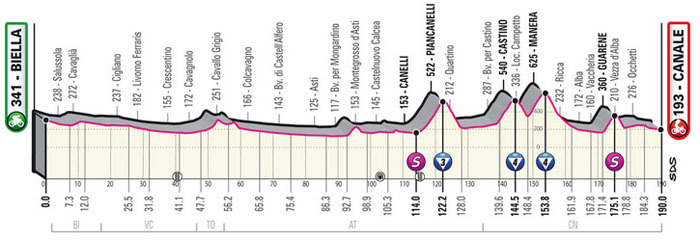
A hilly day where the three categorised climbs are the easy ones, they’re all on a big wide road with a steady gradient. It’s the bump late in the stage that is the trap, a hard climb twisting in the vineyards outside Alba just 15km from the finish.
Stage 4 – Tuesday 11 May
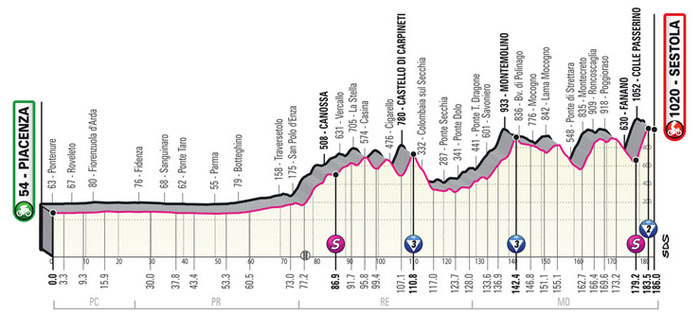
A return visit to Sestola, the Giro has visited several times with the likes of Peter Weening and Giulio Ciccone winning recently. The hard part is the climb out of Fanano to the Colle Passerino and with 4km at a hard 10% to make a selective finish.
Stage 5 – Wednesday 12 May

A a trip along the Adriatic coast to Cattolica, a town with no particular religious significance despite the name. Instead it’s a seaside holiday town, the finish is on the lungomare and the Giro returns for the first time since 1978 when Rik Van Linden, a Tour de France points competition winner, won.
Stage 6 – Thursday 13 May
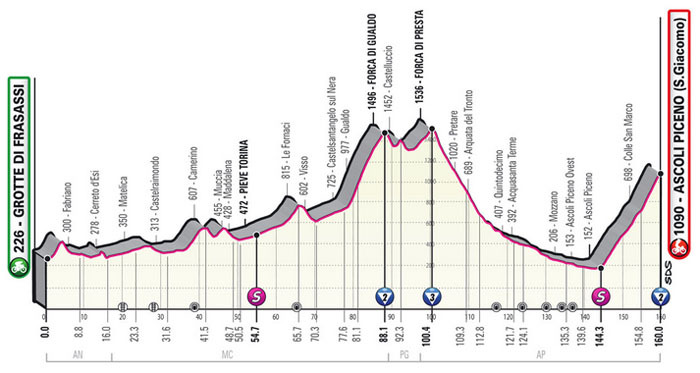
Ascension day and short mountain stage with the climb to the Colle San Giacomo above Ascoli. It’s a long ascent, 17km at an average of 6% but the last 5km bite with some 8-10% sections to make this finish an important discovery day for the GC contenders.
Stage 7 – Friday 14 May
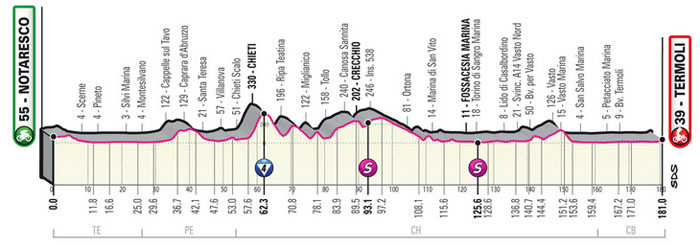
A day for the sprinters with the seaside finish in Termoli, there was a sprint finish in 2006 when Paolo Bettini celebrated only for the photofinish to award Tomas Vaitkus the win.
Stage 8 – Saturday 15 May

As far south as Giro reaches this year and it’s still north of Napoli. The race heads into the Matese, a chain of mountains that’s part of the Apennines and a finish in Guardia Sanframondi with a tough climb past the olive groves. It’s a good day for a breakaway.
Stage 9 – Sunday 16 May
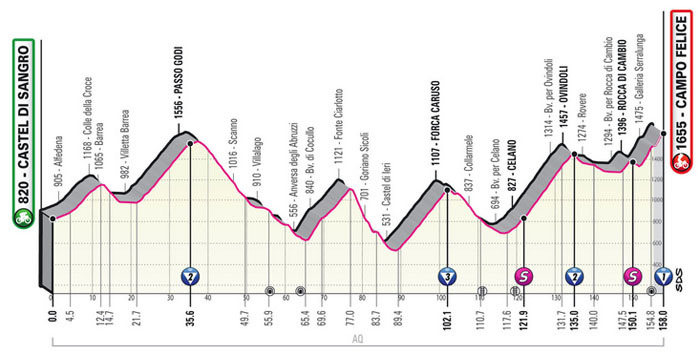
A return to Rocca di Cambio, with a twist. There’s a climb up to the Campo Felice ski area and then onto a gravel track that’s a ski slope in winter, this final section includes 10% slopes to the line.
Stage 10 – Monday 17 May
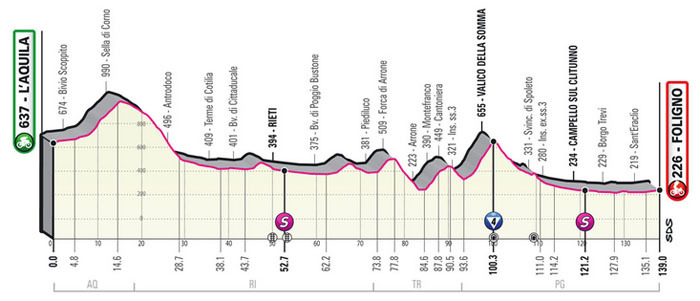
A fitness test for the sprinters with the Valico Della Somma 40km from the finish, most should make it as it’s a main traffic artery and it’ll help spice up the stage ahead of the Giro’s first rest day.
Stage 11 – Wednesday 19 May
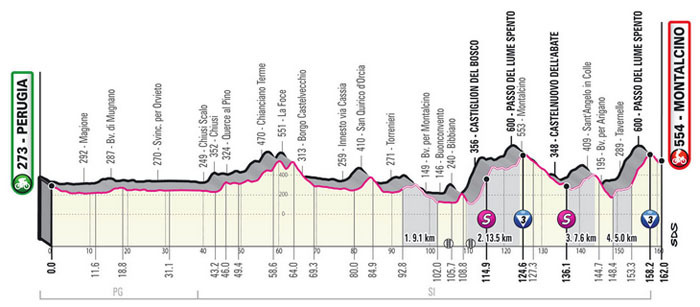
A big day, this is the strade bianche (sterrato to locals) gravel stage and the wine stage. It’s back to Montalcino, famous for its Brunello wine and for the vintage stage of the Giro in 2010 won by Cadel Evans when the white roads turned beige and grey in a downpour and riders looked like they’d been carved out of marble. The roads are different this time but it should be one to savour.
Stage 12 – Thursday 20 May

A mountain stage? It looks like it on paper but out on the road it’s not so hard, a lot big ring riding and this is one for the breakaway.
Stage 13 – Friday 21 May
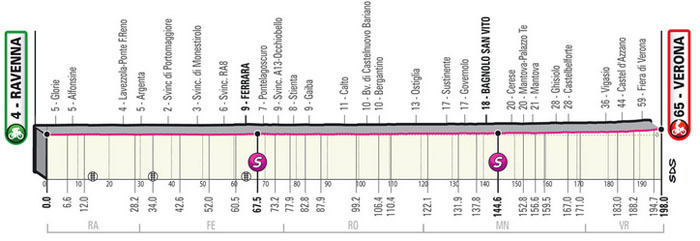
Friday, the 13th stage and a TV commentator’s nightmare, almost 200km across the Po plains and as flat as a piadina. Check for crosswinds just in case but otherwise this is a TV viewer’s rest day, tune in late to savour the sprint as there few of them in this year’s Giro. This stage helps deliver fresher legs for the weekend ahead.
Stage 14 – Saturday 22 May

A return to Monte Zoncolan, a name that strikes fear into anyone without a compact chainset. Only this time it’s the Sutrio side, climbed only once by the Giro in 2003 and easier. It’s relative though, after 8km of 7-9% which is selective enough the road kicks up and there’s 3km of vicious 12-16%.
Stage 15 – Sunday 23 May
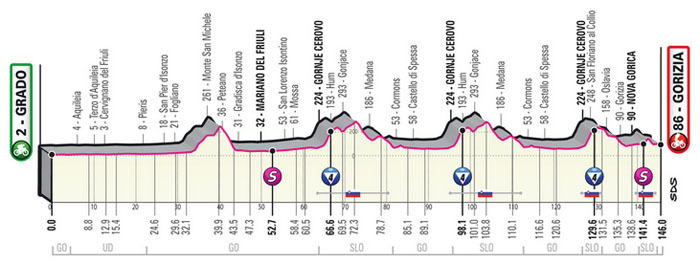
A circuit race with the finish in a city that’s Nova Gorici on one side of the river in Slovenia, and Gorizia to the Italians on the other, and the site of giant battles during World War One. The stage features a hilly circuit as the name Gornje Cerovo implies before a finish back on Italian soil.
Stage 16 – Monday 24 May

Book Monday off work. The tappone, 212km and into the Dolomites for 5,700m of vertical gain. If that’s not hard enough, remember it’s May and many of the higher sections will be lined with snow, there’s a lot of time at altitude and in the cold… assuming the roads are open. The Pordoi is this year’s Cima Coppi high point. The early climb here gives the breakaway a chance to get clear but behind all the GC contenders and their teams will be up for this one. A rest day awaits in Cortina.
Stage 17 – Wednesday 26 May
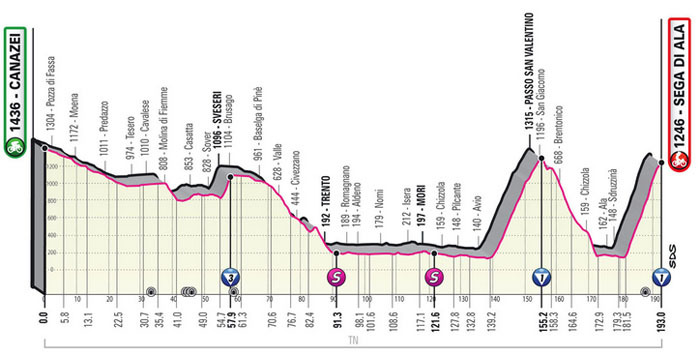
193km and the action saved for late. The San Valentino to soften up the group and then the Sega di Ala – the Passo delle Fittanze for locals – as the summit finish and used once before in the Giro del Trentino in 2013 when Vincenzo Nibali won the summit finish weeks before winning the Giro, and Bradley Wiggins tossed his bike away and it wheeled to stop by a wall. It’s an irregular climb, far more awkward than it looks on the profile.
Stage 18 – Thursday 27 May

228km in the third week, it better not rain. It’s a stage to Stradella, where the Po plains stretch out again, where the road is grey and the light is grey… or at least that’s what Paolo Conte sings. Riders will find their lungs moving like accordions in the finish as the race dips into the Pavese hills with some sharp climbs, any sprinters still left in the race won’t have it easy.
Stage 19 – Friday 28 May

The second Giro start in Abbiategrasso in a year, but only because it was appointed in haste last year when the rider strike prompted the start of the day’s stage to be cancelled and the convoy convened here. The real story though is the novelty, the new summit finish. First there’s the climb up Mottarone, the mountain between Lake Maggiore and Lake Orta which the Giro’s used before then it’s up the Passo di Colma – a pleonasm as colma means pass – above Varallo and then into the Valsesia, a remote valley, before the finish in Alpe di Mera, more a car park than a ski resort but a tough climb, 10km with 7-8% to start and then the second half is over 10% and if anyone’s on a bad day they’ll discover the missing “D” in Alpe di Mera.
Stage 20 – Saturday 29 May

The race isn’t done with the mountains with 4,300m of vertical again. After a start in Verbania – home to Filippo Ganna – the race itself moves to Switzerland and its smooth roads via the long Passo San Bernardino, 30km of climbing and some steep sections but largely a drag. Then there’s the Splügenpass, another long pass and again with some steep parts but not too hard and the two climbs are ideal for a strong team to keep the race under lockdown. A tricky, irregular climb leads to the finish.
Stage 21 – Sunday 30 May
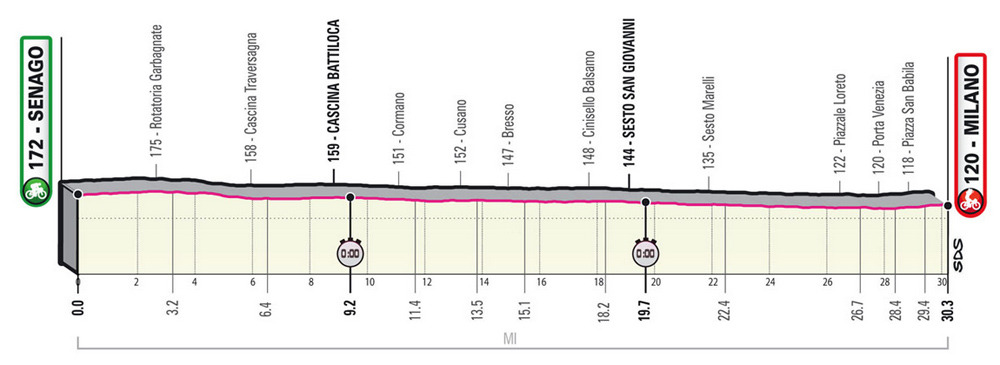
A 30km time trial from Senago to Milan much like last year’s final stage, it’s flat and fast.
The Jerseys

There are four jerseys in the race: pink, cyclamen, blue and white.
Pink: the most famous one, the maglia rosa, it is awarded to the rider with the shortest overall time for all the stages added together. As such, they have covered the course faster than anyone else. It is pink because the race has been organised by La Gazzetta Dello Sport, a newspaper printed on bright pink paper. It is sponsored by Enel, an energy company.
There are time bonuses available on all the stages except the time trials:
- 10-6-4 seconds for the first three riders respectively on each stage
- 3-2-1 seconds are available for the first three riders at the second of the daily intermediate sprints
Cyclamen: the points competition. Riders score points at both of the intermediate sprints per day and at the finish line. The allocation of points depends on the stage in question, they are categorised with the typical sprint stages offering more points in a bid to place the purple-toned jersey on the shoulders of a sprinter who can handle arithmetic. The maglia ciclamino is sponsored by Segafredo Zanetti, a brand of coffee that also sponsors the Trek team.
- Category A+B stages (Stages 2,5,7,10,13,18) offer points for the first 15 riders at the finish: 50-35-25-18-14-12-10-8-7-6-5-4-3-2-1. For the intermediate sprint there are points for the first eight: 20-12-8-6-4-3-2-1
- Category C stages: (Stages 3,4,6,8,12,15) offer points for the first 10: 25-18-12-8-6-5-4-3-2-1. For the intermediate sprint there are points for the first five: 10-6-3-2-1
- Category D+E: (Stages 1,9,11,14,16,17,19,20,21) offer points for the first 10: 15-12-9-7-6-5-4-3-2-1 and for the the intermediate sprint there are points for the first eight: 12-8-6-5-4-3-2-1
Blue: the mountains jersey. It is sponsored by Banca Mediolanum, a bank. There are five categories of climb and note the weighting towards first place.
- 11 fourth category climbs: the first three riders crossing the top of the climb win 3-2 and 1 points respectively
- 11 third category climbs: the first four riders over the top get 9-4-2-1 points
- 9 second category climbs: first six riders get 18-8-6-4-2-1 points
- 12 first category climbs: the first eight riders get 40-18-12-9-6-4-2-1 points
- CC or Cima Coppi: a special award, the “Coppi Summit” for the highest point of the race. This year it is the Passo Pordoi on Stage 16. The first nine win 50-30-20-14-10-6-4-2-1 points
White: for the best young rider, this is awarded on the same basis as the pink jersey, except the rider must be born after 1 January 1996, ie aged 25 or under. It is sponsored by Euro Spin, a discount supermarket.
Now a rider can’t wear two jerseys at once, they’d get too hot and the sponsors wouldn’t get the exposure they’ve paid for. So if a rider leads several classifications, they take the most prestigious jersey for themselves and the number-two ranked rider in the other competition gets to wear the other jersey. For example if a rider has both the pink jersey and the blue mountains jersey they’ll wear pink whilst whoever is second in the mountains jersey will sport blue jersey. The hierarchy is pink > points > mountains > white.
There are also other prizes and in-race competitions such as the intermediate sprint competition held at the second intermediate sprint each day; the breakaway prize for the rider with the most kilometres in the breakaway; the fighting spirit prize which is a combined competition for scoring across the points, mountains and so on; the team prize; and the fair play prize for teams that avoid fines and penalties.
Time cuts
All riders have to make the time cut each day to stay in the race and this is a function of the stage type and average speed:
- Stages 2,5,7,13: the winner’s time plus 7% if the average speed is less than or equal to 40 km/h; 8% if the average speed is between 40 and 45 km/h; 10% if the average speed is over 45 km/h
- Stages 10 and 18: the winner’s time plus 9% if the average speed is less than or equal to 37 km/h; 10% of the average speed is between 37 and 41 km/h; 11% if the average speed is over 41 km/h
- Stages 3,4,6,8,12,15 the winner’s time plus 11% if the average speed is less than or equal to 35 km/h; 12% if the average speed is between 35 km and 39 km/h; 13% if the average speed is over 39 km/h
- Stages 9,11,14,16,17,19,20 the winners’ time plus 16% if the average speed is less than or equal to 30 km/h; 17% if the average speed between 30 km/h and 34 km/h; 18% if the average speed is over 34km/h;
- For Stages 1 and 21, the winner’s time plus 30%
The unmissable stages
Anything can happen during the Giro but there are some stages that matter more than others.
- Stage 4 features a hard climb to the finish
- Stage 6 is another early test for the GC contenders
- Stage 11 for the gravel stage to Montalcino
- Stage 14 with Monte Zoncolan
- Stage 16 is on a Monday but the biggest stage of the race
- Stage 19 the new Alpe di Mera summit finish
- Stage 20 for the Alpine scenery and the hard finish
- Stage 21 the final TT if things are close

TV
New for 2021, all stages will be broadcast live from start to finish although the RAI press release talks about “increasingly advanced and high performance technology” which doesn’t sound like the tried and tested TV broadcast and could mean fingers-crossed for a 4G signal in the countryside. We’ll see. More certain is that Eurosport-GCN is covering the race and some stages will be on Eurosport 1 but watch out as some are reserved for subscribers via the online Eurosport Player or the GCN app.
Italian host broadcaster RAI offers the richest coverage with experienced commentators as well as roving reporters on motorbikes to add extra coverage, it’s on TV and radio in Italy and the geo-restricted website RAI.it. The timing varies but as a rule the finish is expected for around 5.15pm CEST each day.

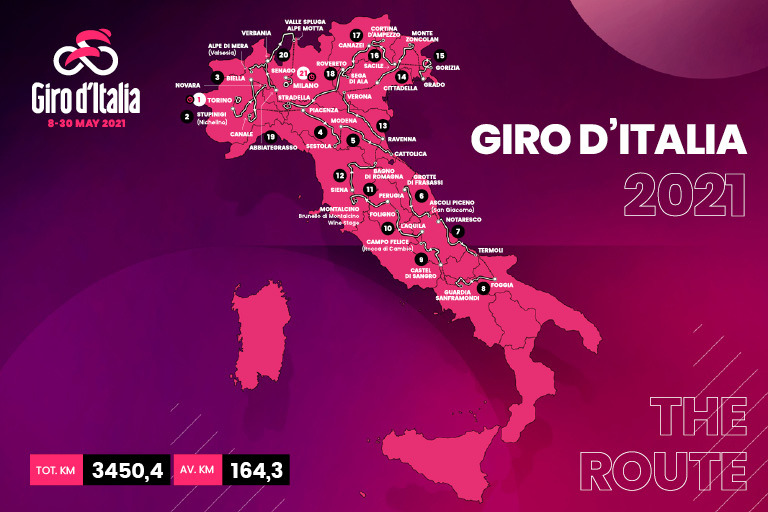
“place the purple-toned jersey on the shoulders of a sprinter who can handle arithmetic’
chortle
Looking forward to this, so thank you for the stage previews and for your in depth coverage. Any idea why ITV don’t manage to get the rights to this?
Not well-known enough to UK general public for ITV to pay for it.
I remember the UK media going big on the Giro when Wiggins went in 2013 but we know how that worked out. It seems in many of the “newer” countries to the sport that selling races beyond the Tour de France is hard, it tends to be the core cycling audience who tune in which is what Eurosport has already and they’ll be testing this with the GCN/Player subscribers even more. In the UK ITV has the rights to ASO’s classics like Liège, Roubaix etc but think I’m right in saying they don’t broadcast them.
And if we needed any more to indicate the current depths of Italian cycling there’s: https://www.indiegogo.com/projects/support-vini-zabu-pro-cycling-team–3#/faq
Sad, really sad 🙁
Well at least they’re doing something… to be generous. It is odd, a “we can’t afford to clean up the team, maybe you can pay?” message. The team doesn’t have a big fan base either, maybe they can tap some Tuscan locals but they’ll struggle for €0.5 million unless some new sponsor comes in.
No, but you should be able to watch it on Quest which is on UK freeview.
UK highlights will be on Quest as well as Eurosport, which (provided it’s included in your TV package) is handy because Quest have much more stable schedules. You should be able to watch at the advertised time, instead of missing half the race on Eurosport because live coverage of the Bulgarian national tiddlywinks championship has overrun. 🙂
At this point, it’s well worth paying GCN £40 (they often do half-price offers) in order to watch all the races, advert-free, being able to rewind if you’ve missed the start, or watch replays (available pretty much as soon as the races have finished) if you’re busy during the day. You can even switch language in order to avoid Carlton Kirby’s “commentary”.
Yep, unless you are in North America where half the races are blocked from GCN. Not really a complaint (glad to have the races we get) but it ain’t all beer ‘n skittles…
The Inner Ring is correct that Liege and Roubaix are not broadcast on ITV in the UK. The Dauphine, Paris Nice, Tour and Vuelta are though
Last year you could stream the Quest highlights in the UK after they were broadcast. It was a fairly unsophisticated player so you could just skip past the adverts should you so choose.
I have been somewhat disappointed with some of the GCN+ highlights shows so far this year due to them showing a large chunk of the early part of sprint stages then cutting from 10km to 1km, missing a lot of the action.
If memory serves me right, due to G Thomas’ GC bid, S4C had Giro 2020 coverage, which you could watch live on BBC iPlayer. That investment turned out well for them 🙂
Looking at their upcoming schedule, it *looks* like they might be showing it again:
https://www.bbc.co.uk/programmes/p077p6zd/broadcasts/upcoming
Grazie! My favorite time of the year, this year tempered by the pandemic 🙁 If not for that I’d be up in Piedmont next week for the early stages and back again for the latter ones as they come back 🙁
And then there’s the stages in-between like: http://cycleitalia.blogspot.com/2010/05/saturday-in-hell-or-heaven.html or http://cycleitalia.blogspot.com/2018/05/giro-ditalia-stage-20-cervinia.html
Instead we’ll be in front of the TV, toggling between RAI and Eurosport Player here in Sicily which on the whole is pretty f__king good 🙂 W Il Giro!
I think as long as Bernal isn’t at his best, this could be a very open and interesting race. I don’t think Bernal has yet proved himself a very strong grand tour rider (he beat a team mate and Kruijswijk to win the 2019 Tour de France, and was slower than Pinot in the mountains before Pinot got injured), but fully fit he’s still probably the best rider here, plus he has probably the strongest team.
Yes, looking forward to the contest… and typing a preview next week to help think about the contenders and what could happen. Evenepoel’s a mystery, Yates is in very good form etc
There appear to be quite a few intermediate sprints with bonus seconds near to the finish. A quick look back at last year suggests that there are more of them last year. Do you think this will have much impact on the race? I seem to recall the late in the stage bonus seconds on the final road stage dictated who was in the pink jersey on the final day last year.
Yes, although still waiting for the Giro to publish the rulebook, normally only one of the intermediate sprints per day has bonus seconds – probably the latter – but we’ll see. It’s not free time has the sprint is an effort but helps, normally they’re only 3-2-1 seconds though. Last year’s Giro was close in part by chance but also by design as the courses are being engineered with the aim of keeping suspense to the end. This year’s route though should do the kind of damage that the time bonuses shouldn’t change.
The garibaldi is here: https://issuu.com/giroditalia2020/docs/garibaldi_2021_bassa_rid
Thanks, only it doesn’t usually have the rules in it though, that’s in a separate book. The first rule of stage previews here is never to look at the race roadbook but do your own homework in order to map and explore the route… you can often spot when others don’t and read/copy from the roadbook.
And that’s why we keep coming here – deep insights that aren’t found elsewhere. Dank je wel!
Has anyone worked out how to download it/print it? The Issuu platform doesn’t seem to accommodate this.
Stage 3 – I hope no DS is reading, or this should go with a spoiler alert. The caption’s right, and twice so. The “late bump” may refer to the Guarene *sprint* (how ironical), which even in the Garibaldi got the “full camouflage” treatment that the Giro’s cartography sometimes uses to work out its little surprises: apparently a 6-7% affair, half Poggio half Cipressa, just enough for a late thrill with the sprinter teams chasing full gas to bring their men back into contention during the last 20 mins or so. But how come that a climb whose partial gradient are always some 6.2-6.8% gets an average of 7.2%? Well, that last km might turn out a bit peculiar. A sudden 120º left turn, nearly an hairpin, turns a steady 6.5% on a relatively wide road into a narrower 300m long stretch ramping up at 10% through the vineyards. From then on, right when a short false flat makes you think you’re over the hill, the street becomes even narrower, barely the space for a single car through old houses and high walls, jumping up with 12 to 15% sudden steps. The last section to the top, preceded by a U-turn-like hairpin on (easy) cobbles – what if it rains? – consists of 200m with an average 15% gradient. Bad positioning, a bit of forcing on the front, and anybody could find himself on the wrong side of one or more splits. The second element which inrng’s “late bump” might refer to is barely visible on the profile, let alone receiving any sort of categorisation. Indeed, it’s not as significant as Guarene, but it could shift the balance in a tight finale. Some 6 kms to the line an already lined-up bunch will face a 300m 9% ramp peaking up at 12%, along the Pieve di San Pietro, in Occhetti. It’s a twisting, quite narrow country road, so they won’t see it coming. Nothing to worry about when keeping the wheels is concerned, but a train already on its limit might get derailed. Wrong gear alert. Might be worth watching, although it shouldn’t be about GC in any case.
Stage 4 – It’s not just about the finale, or at least not necessarily so. It’s a little “wall” stage, albeit not as hard as those in Tirreno, that’s for sure. Check the Montemolino climb, some 43 kms to the line, for example. They chose the hardest way up the climb and the last 2.0 kms *average* some 11.6%. Tiny road, 18% ramps, no actual descent available once it’s over but an albeit favourable false flat. They can stroll over it, for sure, yet if they don’t, prepare for a tense final hour, given that meanwhile you also need to face the Montecreto wall halfway to the finish.
Stage 6 – The Forca di Gualdo they use to climb up to the beautiful Castelluccio plateau isn’t a easy climb, not at all, especially its first half. Quite far from the line, no doubt – it’s not about attacking here and getting to the line alone (well, Simon Yates might want to have a try); but have a look to see if some team is interested in shaping the race.
Stage 12 – Just like you, I’ve got a strong feeling that it may well turn out to be once again a disappointing copy & paste of similar stages in recent years on these otherwise utterly beautiful roads. Yeah, what makes for a very hard Granfondo or an exhausting but compelling touristic raid, well, hasn’t been working *that well* among the pro. However, let me point out (wishful thinking) that this year it’s not that much “big ring riding” – actually, only Passo della Calla might be defined so (if the Consuma tricks you into the big ring, as it might well do, you’d be quite sorry in the last couple of kms before it flattens up near the top). Of course, of course, that means anyway no inner ring from 80 to go until the last 20 kms. Yet, beware that last climb. They’ll have tired legs after 200 kms (and the sterrato stage the day before). 3 very hard kms (not long, admittedly) and a rolling section to attack deep before a very fast, occasionally technical, descent. This is harder – in a pro race – than the Novecolli stage last year or than Fraile’s in 2017. One for the break? Well, very probably so. At least, they tried to spice things up. Just a little.
Stage 18 – No, it won’t come easy for the sprinters. By the way, who among them will climb Zoncolan, the full Dolomiti package with Fedaia and Giau, and then Sega di Ala, too, in order to face these 231 km (rainy, perhaps?) and possibly get dropped on the very last hill (232 m slm)? ^__^
Stage 20 – As I wrote here, I half-heartedly hoped that they avoided the tunnel and climbed up to Madesimo via the “old road”, where “road” is pretty much an overstatement. Early map suggested the tunnel – but now, well, apparently it became official that they’ll tackle the “old road”, indeed. More of a cycle path, or a mule path of sort – actually reserved for walking or cycling. 1 km averaging 12% instead of 1.5 km at 8%, it won’t probably change the race but it sure makes even more appropriate the definition of “tricky, irregular climb”. By the way, I suspect that it’s not what we see in the official profile of the climb, yet the rest of the race material state it clearly. San Bernardino and Spluga are a bit borderline, IMHO. Not that regular (althoug the top section of San Bernardino quite much is), they lack sustained high gradient, but they sure have several hard sections to shake things up. Nerves, at least. The last 4 kms of the Spluga are no Agnello or Finestre but can be testing, and they’ll be racing around or over 2000mts of altitude.
Thanks for the insights, Gabriele. With this and Inner Ring’s guide, I feel fully prepared now.
+1
Great insights there Gabriele, good job
Thanks all, for the detail overview
fingers crossed for few covid DQ’s
[prints out comment to cross-reference with daily stage preview notes]
Thanks. The more I look into this year’s route, the more I like it.
> The more I look into this year’s route, the more I like it.
Yes, I was a bit underwhelmed when I first saw the route, even more so given that I hadn’t had the time to follow all the traditional leaks and investigations which often take you to the official unveiling of the course after having already discovered it little by little during the previous months.
At first, I found that it lacked a bit of charm – say, the hype effect of mythical climbs, or some innovative course concepts or, again, new and/or long-waited-for uphill finishes… that sort of emotional little things. Sure, the Strade Bianche stage, the Dolomiti marathon stage, but the rest apparently wasn’t enough to create special expectations. As I looked into it more and more, I started to appreciate the variety of options it offers and the ambush chances granted precisely by some stages whose design doesn’t catch the eye at first sight. The different types of stage are very balanced and well distributed.
I still think that it lacks ITT kms, and especially some “technical” ITT, the sort of course design which since some years ago have made many of the Giro’s ITTs so great – probably the best around and copied by everybody else.
And I’m not very convinced by an excessive stress often placed on the very last climb, which is so many times the most defining moment of the stage, thus hindering a little the interesting route which comes before it.
Better said: we’re very far from a “monoclimb” approach, since most stages grant many occasions to play your cards in a strategic way, sapping your rivals’ energies still far from the line, or isolating them, or launching men on the front with a break. Yet, the tactical dimension of a captain moving before the final key climb will be harder to see.
I miss some “Mortirolo-Aprica effect” out there: more often than not, you could even detect a “reversed Mortirolo-Aprica effect” – the penultimate climb is a bit easier and more favourable to groups and teamwork (Pordoi -> Giau ; Colma -> Mera ; Calla -> Carnaio… and you could add others).
Perhaps, it’s just that Vegni has forwarded the “Mortirolo-Aprica effect” one climb back, and then added a final, harder climb (Fedaia -> Pordoi -> Giau ; Mottarone -> Colma -> Mera ; Consuma -> Calla -> Carnaio and so on). But I doubt it actually will work that way…
Finally I think that the first week may end up being more entertaining than in some previous very recent editions, although, OTOH, I suspect that the first mountain weekend (Guardia Sanframondi and Campofelice) could prove itself less compelling than in other years. At the end of the day, both stages look more like a côte uphill sprint for one-day specialists (with GC men in the mix, for sure) rather than an actual mountain finishes. Stage 9, of course, being so short and heavy-loaded in its first part, could produce some better racing, but it really needs a team or two going “Astana 2015” – otherwise, it’s all about those final 1,600 mts of 8-10% sterrato.
“San Bernardino and Spluga are a bit borderline, IMHO.” In what sense? I ask this before I’ve been down to my trusty newsstand looking for Bicisport’s always excellent GUIDA…perhaps tomorrow though I have yet to see news that it’s out yet. Great details either way, grazie Gabriele!!! 🙂
I meant that they were “borderline” between the typical large, engineered, drag climb (which they sure are, especially the San Bernardino, which often goes side to side with… an highway!) and the more classical sort of “Italian” alpine climb, with that vicious sudden rise in steepness here and there, from time to time: especially on some “drittone” (large, straight, unrelenting segment) where the combination of a 12% gradient and a wide road makes you feel even worse, and that’s the case of San Bernardino. The Spluga – equally a “too-well-engineered” climb on the Swiss side – is more traditional, but clearly a bit narrower in its top section, with lots of hairpin and a suffocating gradient which gets progressively harder and harder from 8 to 9% through the last 4 kms.
I think that the San Bernardino will be essentially tactical (but somebody might discover he’s got a bad day way too soon): its top section is too favourable to group riding and there are still some 20 kms before they tackle the Spluga. However, if the race for any reason gets split, it could really go havoc for that same reason. Not probable, but, hey, it’s the Giro.
On the contrary, I’d take into serious consideration some sort of move on the top of the Spluga, if I needed to shake GC a bit. It’s 20 kms again before the last climb starts, but this time it’s essentially a very fast descent (they drop ~1000 mts not 600 as before the Spluga), and there’s no long intermediate false flat section, barely some 3 kms along the lake.
OK, thanks. Now I’m really wanting to get my printed GUIDA as I enjoy looking at the map sections way more than the elevation profiles but I don’t care much for ’em online, even at the Giro d’Italia official site. Of course Bicisport’s GUIDA also features the best regional foods and wines of each stage as well, something else I enjoy much more in print, though of course not nearly as much as with a fork or glass!!! 🙂
W Il Giro!
Everything you’ve put in here pretty much sums up why I love the Giro so much!
That’s fantastically detailed Gabriele, thank you
I seem to recall talk of the cortina stage finishing with the tre cime. Any idea why this got dropped? Logistics or too hard? Or was it just my imagination?
Maybe just too hard, adding the Tre Cime onto a stage with already 5,700m of vertical gain is plenty, and increases the risk that riders huddle right until the end for fear of cracking.
Adding the climb up Tre Cime (and a climb to Misurina where it really starts) to Stage 16 would be a bit much even for Zomegnan IMHO. The current final climb – Passo Giau from that side is really, really tough, especially with the Passo Fedaia (and to a lesser extent Passo Pordoi) already in the rider’s legs, so adding any more might end up turning the stage into a boring “death march”?
Is the points jersey based on cyclamen hederifolium or on cyclamen repandum, that is the fundamental question.
Repandum, I think. That is the brightest pink/ purple, and it is native in the Italian mountains.
Is 5,700m of climbing in a stage extreme, historically speaking? (I never remember these things.)
(as an aside: I read much of Max Leonard’s Lanterne Rouge on your rec the other week; a fun read and the stuff about Wim Vansevenant was great.)
It’s a value which would score high in most historical sets of stages, but it’s not extreme, surely – it perhaps would be exceptional at the Vuelta, but not at the other two GTs.
For example, at the Giro it wouldn’t even enter a top ten of stages with the most climbing since 1990. At the Tour it would have more chances, given that *after 1998* we had mountain stages with at least 5,500m of climbing only 5 times.
The Tour surely softened up quite a lot in the last couple of decades, given that in the 80s and in the 90s they had stages with >5,700m of climbing more editions than not. Worth remembering the famous Sestriere stage in 1992, with Chiappucci’s long raid, or the Morzine one in 1983 with Arroyo equally working out a final runner-up position, cutting out half of the difference which separated him from Fignon. Both stages broke the 7,000m barrier of climbing.
The Giro became exceptionally soft in the 80s, as it’s well known, in order to allow Moser and Saronni to battle for GC. Yet, as the 90s started, they again offered serious mountain stages: in the 90s, only one edition didn’t have at least one stage with 5,700m of climbing… or more (often closer to 6,000m). Things got a bit easier south of the Alps, too, since the year 2000.
Yet, the main difference between the Giro and the Tour is that in France at least 80% of the mountain stages with the most climbing happened from 2005 to 2008 (with the main exception, an isolated one, in 2001), whereas the Giro sort of spread them through time, with a real “tappone” every 4-5 years (2001, 2005, 2011, 2012, 2017, 2020).
What’s even more shocking is that the Tour essentially renounced to go over the 5,000m of climbing barrier from 2012 to 2017, both included.
Again, it’s something which happened at the Giro, too, but only from time to time, at least since the Zomegnan era (2004, 2008, 2010, 2014, 2018 + 2013 because of the snow).
It’s a bit as if the Giro has been alternating different design approaches with sort of a turnover logic, whereas the Tour, within a general pattern of climbing reduction, sticked with a given approach for longer “blocks” of consecutive years, for whatever reason. Climbs were back steadily since 2005 to 2009 at least, and they were taken away again in 2012. Now, luckily, we’re being granted again some heavy climbing at the Tour, too.
Thanks a bunch. Very interesting/enlightening.
As a rule anything over 4,000m of vertical gain is a big day out, above 5,000m and things get hard and you want to see what is the day before and what comes next too. In 2012 the Giro had 6,300m on one stage, the one to the Val di Fassa won by Mikel Nieve. In one day they did more climbing than the whole Tour de Romandie that year, which is after all a very hilly stage race in the Alps (this year’s edition is has the most vertical gain ever with 12,000m).
But like all single measures it doesn’t tell the full picture, if altitude is the y-axis, then distance is the x-axis and so how long the stage is can matter, a long stage can be hard but paradoxically can mean the climbing is easier as it’s spread out more. There’s no escaping the work needed to lift you and your bike up the amount during a stage but if it’s all on 4,5,6% gradients it will feel a bit easier than a more concentrated stage with steeper gradients of, say, 7-10% and then there’s the weather, if it is cold and wet, or very hot then this compounds the effects, the descents start off feeling like rest but in time get tiring, and also the time spent at altitude. The Giro stage this year is a hard route and fingers crossed for the weather.
Certainly poor weather in Romandie the last couple of days.
A few riders gone down already, I’m just hoping that Sebastien Reichenbach doesn’t fall otherwise that could be The Final Problem.
Did he fall or was he pushed? After all, Moscon is riding also this year…
(+1 for the Conan Doyle reference – more of this, please!)
Ah, that was the reference! It was right on the edge of my consciousness, but the coin didn’t drop. Yes, nicely done.
“There’s no escaping the work needed to lift you and your bike up the amount during a stage but if it’s all on 4,5,6% gradients it will feel a bit easier than a more concentrated stage with steeper gradients of, say, 7-10%..”
Easier might be relative in that IMHO a bigger, more powerful rider finds it easier to contain pure climbers (those slightly-built guys who stand up and take off when it gets steep) on the long slogs (drags, etc.) on big, straight roads with those lower gradients. Worse, those rarely give you an idea of how much elevation you’re gaining and too often seem like you’re stuck in-place on a set of rollers. Throw in a headwind and for me there better be a cold beer at the top and a fun descent down the other side, or I’m in the car 🙂
Elementary my dear Larry 😃
Dunno if it’s so elementary my dear Ecky, I think some of the way-into-the-numbers types see only total elevation gains rather than how steep the climb might be. The current “Everesting” fad would seem to play into this, no? None of those folks are riding up and down the Mortirolo, Zoncolan or Angliru multiple times, are they?
I agree Larry. Those long climbs that just drag on forever on a seemingly barely perceptible gradient can be a living hell. It might be a mental thing because you feel like you should be blasting along in the big ring, but instead you’re twiddling away in your smallest gear not getting anywhere. Obviously I’ve never raced up an alpine pass though. Sitting in the bunch might be a different matter altogether, but generally speaking I prefer a gradient where you feel like you’re gaining some height!
In my (brief) racing “daze” I was off-the-back pretty much as soon as the road went up, but as a cicloturista I’ve slogged up pretty much all of the famous TdF and Giro d’Italia climbs with a few exceptions. While Mortirolo or Zoncolan are climbs I’m not keen to repeat, climbs like the Passo Pordoi offer me the best effort/reward ratio via plenty of switchbacks and views that allow you to see that your efforts are getting you somewhere.
For me the worst of the “slogs” is the straight stretch on Passo Fedaia…I’ve probably ridden up that close to a dozen times and every one of ’em had me thinking my tires must have gone flat, BB spindle seized up or I was somehow planted in the road on a set of rollers! The final-insult on that one is when you finally hit the switchbacks at the top and see the 16% sign….just when you thought you’d already done the toughest part.
FWIW Mortirolo and Zoncolan have been “Everested” and while I’m too lazy to look it up – you can do a quick search or check the map at the Everesting web site – I’m pretty sure that someone has succeeded in Everesting Angliru as well.
Lots of factor at play, yet as a side note it’s worth pointing out for precision’s sake that everesting for the record (not that interesting a discipline to me…) is recently being done repeating and repeating very short, very straight, very steep (averaging 13 to 15%) segments. The idea is that aero shouldn’t factor in while climbing, that the total course in kms should be as short as possible, and the descent shouldn’t include curves, apart from the necessary U-turns to go back and forth. Among women, Emma Pooley holds the record climbing a proper Swiss climb, with its bends and so – nearly 7 km *averaging* 13%.
Eskerrik Asko – thanks for the correction! Shows how much attention I pay to things like “Everesting”, “Zwifting”, “Straving(?)” and the rest of the activities that substitute for racing for those IMHO seemingly afraid to pin on a number and actually get out there and mix it up.
“Accident prone” Thomas strikes again.
From the article and comments it sounds like a great course. I hope the riders make it great!
I meant to say: not often one reads (with one’s own eyes, no less) the term “pleonasm” in a cycling write-up. Nice! Anyone know how the Passo della Colma got its name?
There are lots in Italy like this, the Passo della Foppa, Passo dello Forcella, Passo dello Zovo etc where Foppa, Forcella and Zovo are examples local words/dialect for a pass. You can imagine locals pointing to “the pass” in their language and then some map maker from Milan or Rome labelling it “[Pass] of the [Local word for Pass]”.
“In April 1945, during the Second World War (Passo della Foppa) was the scene of two battles between the partisans and the German-fascist troops retreating towards Trentino. Keep in mind that “Mortirolo” refers to the dead and the fighting of the First World War.”
“Foppa, a hamlet of Berbenno di Valtellina, an Italian town in the province of Sondrio.”
Grazie Wikipedia Italiana!
Thanks for the guide inrng. Some minor route updates happened since you published this – the final TT is 30.3 km, the Bagno di Romagna stage is now 212 km long and to me the final climb Passo del Carnaio looks harder than what it seemed earlier.
I am intrigued about the transfers between stages. Not one stage starts in the same place as the previous day’s finish
Thanks for spotting the updates, think that’s the third time they’ve changed (some readers might need to refresh/clear caches etc to see the changes). The transfers don’t look too bad on paper, the distances are relatively short and often via major roads/autostrade although it’ll depend where the teams are staying.
“228km in the third week, it better not rain.” Given what happened last year, this idea to put the onus on the mileage and on the weather and not on the riders is completely unacceptable. It should read: “228km in the third week, IT’D BETTER RAIN, and riders’d better cope with adversity as they are supposed to”.
Me, I’m hoping they learn from Romandie, neutralise the race because it’s cloudy, and then hand two minutes to the break.
I guess it wouldn’t be the Giro d’Italia without some sort of polemics? Gawd only knows what they’ll be this time. As much as I’m looking forward to La Corsa Rosa 2021, I’m finding it a little strange since 2020’s version wasn’t that long ago.
“if anyone’s on a bad day they’ll discover the missing “D” in Alpe di Mera”
I love these (c)inrng nuggets!
That was me.
Glad someone got it 😉
“Alpe di Merda” – nice
Looking at Google Earth, should be great Monte Rosa views from there.
Skimming over the Giro site, I’m rather suspicious of some of the elevation gain figures. For example, 1800m for Stage 4 seems low – supposedly 300m less than the much less lumpy Stage 3. Might there be some Torriani style deception at play…?
That… or a mistake yes, it’s a much hillier day, more like almost double that figure. As you say some of the other numbers are off too.
The race website and roadbook are useful materials but we quote them at our peril, they’re not official maps.
It’s nice that there are a few mysteries, mistaken or not. I am, at least, willing to believe the figure given for Stage 16 – it looks horrific. Looking forward to the race, and your always brilliant coverage!